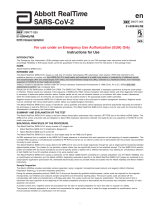7 / 8
Detection System, LineGene 9600 Plus (FQD-96A) or QuantGene 9600
(FQD-96C). Since clinical positive specimen was unavailable, positive control was
prepared for the validation. The positive control was Plasmid DNA fragment, which
contains the target fragments of Neisseria gonorrhoeae, Ureaplasma urealyticum.
★ Limit of Detection (LoD): The positive reference standard was diluted into 1000
copies/mL, 500 copies/mL, 250 copies/mL and 100 copies/mL, then were tested by
3 lots of kits. Each concentration was tested with 20 replicates. The testing data
demonstrated that the kit can detect NG and UU with detection rate equal or higher
than 95% at the concentration equal or higher than 500 copies/mL.
★ Analytical sensitivity: 8 positive reference standards and 8 negative reference
standards were tested by 3 lots of kits. The positive coincidence rate was 100%, and
the negative coincidence rate was 100 %.
★ Analytical specificity: No cross reactivity has been observed by testing the
clinical positive specimens such as HPV16, HPV18, HSV Ⅱ, Treponema pallidum,
Mycoplasma hominis, Staphylococcus aureus, Escherichia coli, Gardnerella
vaginalis, Candida albicans, Trichomonas vaginalis, Lactobacillus frioris,
Adenovirus, Human cytomegalovirus, Streptococcus b, Lactobacillus casei,
Human genomic DNA.
★ Analytical specificity: The potentially interfering substances were spiked into
positive control, then tests were performed by 1 lots of kits. The tested substances
blood, mucin, cervical mucus, vaginal lubricant, anti-inflammatory lotion,
azithromycin and levofloxacin showed no influence on the detection.
★ Precision: Positive controls and low positive controls reference were tested by 3
lots of kits with 10 replicates by 2 operators for 20 days. The results showed that the
variation coefficient (CV) of within-day, between-day, within-batch and
between-batch were less than 5%.
REFERENCES
[1] CW Geraats-Peters et al. Specific and Sensitive Detection of Neisseria
gonorrhoeae in Clinical Specimens by Real-Time PCR. J Clin
Microbiol,2005.43(11):5653-5659.
[2] J Yi et al. Detection and biovar discrimination of Ureaplasma urealyticum by
real-time PCR.Mol. Cell Probes,2005,19:255-260.
[3] CH Boel et al. Evaluation of Conventional and Real-Time PCR Assays Using
Two Targets for Confirmation of Results of the COBAS AMPLICOR Chlamydia
trachomatis/Neisseria gonorrhoeae Test for Detection of Neisseria gonorrhoeae in
Clinical Samples. J Clin Microbiol,2005,43(5):2231-2235.
















